#the worship of artemis in attica
Explore tagged Tumblr posts
Note
Hey! Regarding your last post about Zeus facets, do you have any idea about how he was perceived in cults?
I think this is such an interesting topic! There's no easy answer considering how ubiquitous and widespread his cult was, but for a quick overview I really recommend Jennifer Larson's Ancient Greek Cults. It's far from a complete coverage (for that there's Farnell's psycopathic 5 volume effort The Cults of the Greek States, and even he falls short), but it's an amazing collection of the most significant, fundamental and peculiar cultic aspects of every major god. So for my answer I'm shall offer a shamelessly plagiarised deficient summary of her work.
The most familiar cults of Zeus are the large panhellenic sanctuaries of Nemea and Olympia, where the god was famously honored with athletic contest. This last cult, a meeting place for local chieftans at least since the 10th C. BC, had victors offer massive hecatombs at the center of the sanctuary: a walled precinct called the Altis (Sacred Grove) where a primitive altar stood, a great conical pile of molded sacrificial ashes. The sanctuary also boasted of having one of the Seven Wonders of the world, Zeus' colossal chryselephantine statue. Appart from the awe and majesty, "viewers received the impression of a calm and peaceful deity. According to Dio Chrysostom (Or. 12.51), “whoever is deeply burdened with pain in his soul, having borne much misfortune and grief in his life and never being able to attain sweet sleep, even this man, I believe, standing before this image, would forget all the terrible and harsh things which one must suffer in human life.”"
Earlier cults focus more on Zeus's aspects as a rustic rain deity. As "the" sky god he frequently dwells on the summit of the tallest mountains (Mt. Lykaon in Arkadia, the Oros of Aigina, Ida in Troy, Hymmetos in Attica, etc. until ultimately Olympos) where he was worshipped under titles such as Ombrios (of showers), Aphesios (releaser, in reference to the myth of Aiakos and the drought), Hyetios (of rain) and Ikmaios (of moisture). Rain-magics were common (such as sprinkling water from oak boughs), and he was curiously worshipped on Keos and Mt. Pelion in conjunction with Sirios (the scorching Dog-Star). Fleeces seem to have formed a common part of many of these rituals.
Second only to Artemis, Zeus also had some of the most sinister cults, where mythically humans became the sacrificial victims. In Thessaly, Athamas almost sacrificed his son to Zeus Laphystios (the Devourer), and further strange practices survived to Herodotos' days (Histories 7. 197). Similarly in honour of Zeus Lykaios (wolfish) a secret nocturnal sacrifice was held during which participants ate portions of a “mystery meat” from a tripod kettle, reputed to contain not only entrails of animals, but also a human victim. Several traditions speak of the later lycanthropy of the participats. Zeus always makes a show of refusing human sacrifice in myths, punishing Lykaon and having Herakles berate Athamas, but still rituals that outlived even the roman era paint a darker picture of the god (though there's no archaeological evidence of human sacrifice).
Zeus also dwellt in the cities. An amusing rite was held in Athens in honour of Zeus Polias (of the city), where after the ox had been sacrificed the priest who had committed the deed quickly run off, and the axe that was used was tried for murder. He could also be found as Zeus Boulaios (of the Council), Agorarios (of the Agora), Soter (Saviour) and Eleutherios (liberator), and Zeus Tropaios (of the Rout) was worshipped as the defender of cities in the form of an empty armor placed on a pole. He also resided in the home, where he could be found in shrines dedicated to Zeus Patroös (ancestor), Herkeios (of the Courtyard) or Ktesios (of possessions), this last one embodied in a wool-wreathed jar filled him "ambrosia", that acted as a charm to increase the household goods. In the sanctuary of Zeus Messapeus, near Sparta, other finds were eclipsed by the staggering number of crude clay figures with massive, erect phalloi; presumably votive offerings related to male fertility and fatherhood. He was also syncretised with Zeus Meilichios, a serpentine god of a chthonic nature that deserves a post of their own. His moral attributes where reflected when he was surnamed Hikesios (of Suppliants), Katharsios (of Purification), Xenios (of Strangers/Foreigners) and Exakester (of Making Amends), and as Zeus Horkios (of Oaths) he served as the ultimate witness.
Finally, he had fascinating rites in Crete, where he was said to be born and die every year, and his tomb was shown to visitors (I won't go into details because I'd be here till the cows come home), and he was as an Oracular deity in Dodona, his other major panhellenic sanctuary. His cult title there was Naios (flowing), and together with Dione (the female form of his own name) he delivered prophecies (different ways are given depending on the version or theory: speaking oak-trees, doves, dove-priestesses, ascetic male priests, wind-chimes, lead tablets, etc.). In such a capacity, and as lord of fate, Apollo and other oracular figures were conceived of as his mouthpieces.
Generally speaking, quoting Larson: "His cults typically reinforce traditional sources of authority and standards of behavior, whether in the family, the kinship group, or the city." Still, plenty of his cults where surrounded by an elemental and primitive air. He ranges from majestic and lawful to savage and wild, from rustic to urbanite and from straightforward to mystical. He's the pile of contradictions I love to see in my mythological figures.
#ask#Zeus#sorry for the really simplistic summary#I really recommend Jennifer Larson#and if you're feeling brave Farnell isn’t hard to find#also most specific cults have at least one academic paper written about them
24 notes
·
View notes
Text
Bendideia
~ 19 Thargelion ~
Celebrating Thracian Goddess Bendis, Bendideia was introduced into Athens by Bendis' cult. Popular in mainly Attica, Bendideia focused on celebration of the namesake goddess.

Associated with Artemis, many Athenians who did not worship Bendis celebrated Artemis this day as the Goddess of the Moon and Hunt.
A torch race was held, as well as a festival meal being held with community.
While many modern Helpol do not celebrate this day, it is up for preference if one wishes to incorporate Bendideia into their calendar. It is worth being mentioned and researched however, since it was popular in Attica. As this is a Thracian festival, one might be uncomfortable in celebrating a goddess outside of their pantheon.
14 notes
·
View notes
Quote
Artemis Mounichia, mentioned by Herodotus (8.77), was also worshiped near the sea. Mounichia (modern Mikrolimano), the smallest harbor of the Piraeus, was of major strategic importance and was used in time of war. On its fortified peninsula (now Koumoundourou Hill), a few remnants of the sanctuary of Artemis have been investigated. Its altar was a refuge for persecuted seamen. A second altar was dedicated to Artemis Phosphoros* by the democrats, because the goddess appeared as a flash of fire on a moon-less night and encouraged them in their struggle against the Thirty Tyrants in 404 b.c.
Evgenia Vikela, “The Worship of Artemis in Attica: Cult Places, Rites, Iconography.”
[Artemis Phosphoros: Artemis the Light-Bringer]*
#artemis*#epithets#herodotus#the worship of artemis in attica#evgenia vikela#places of artemis#im gonna be putting up a few posts about cities in Sicily and Southern Italy that worshipped artemis#so im just gonna keep track now#mikrolimano#mounichia#attica#also this is not her only association with water
8 notes
·
View notes
Text
Funny thing to mention: Apollo isn’t the god of the sun

Here's the quote from Theoi:
These characteristics of Apollo necessarily appear in a peculiar light, if we adopt the view which was almost universal among the later poets, mythographers, and philesophers, and according to which Apollo was identical with Helios, or the Sun. In Homer and for some centuries after his time Apollo and Helios are perfectiy distinet. The question which here presents itself, is, whether the idea of the identity of the two divinities was the original and primitive one, and was only revival in later times, or whether it was the result of later speeulations and of foreign, chiefly Egyptian, influence. Each of these two opinions has had its able advocates. The former, which has been maintained by Buttmann and Hermann, is supported by strong arguments. In the time of Callimachus, some persons distinguished between Apollo and Helios, for which they were censured by the poet. (Fragm. 48, ed. Bentley.) Pausanias (vii. 23. &sec; 6) states, that he met a Sidonian who declared the two gods to be identical, and Pausanias adds that this was quite in accordance with the belief of the Greeks. (Comp. Strab. xiv. p. (635; Plut. de Ei ap. Delph. 4, de Def.Orae. 7.) It has further been said, that if Apollo be regarded as the Sun, the powers and attributes which we have enumerated above are easily explained and accounted for; that the surname of Phoibos (the shining or brilliant), which is frequently applied to Apollo in the Homeric poems, points to the sun; and lastly, that the traditions concerning the Hyperboreans and their worship of Apollo bear the strongest marks of their regarding the god in the same light. (Alcaeus, ap. Himer. xiv. 10; Diod. ii. 47.) Still greater stress is laid on the fact that the Egyptian Horus was regarded as identical with Apollo (Herod. ii. 144, 156 ; Diod. i. 25; Plut. de Is. et Os. 12, 61; Aelian, Hist. An. x. 14), as Horus is usually considered as the god of the burning sun. Those who adopt this view derive Apollo from the East or from Egypt, and regard the Athenian Apollôn patrôios as the god who was brought to Attica by the Egyptian colony under Cecrops.
Apollo is the god of light, so…that’s just a huge spread of misinformation on Rachel’s half.

The same is also said towards Artemis. She isn’t considered the goddess of the moon in Ancient Greece, although I don’t have the source of information so keep tight.
63 notes
·
View notes
Text
Children in Ancient (Athenian) Festivals
Religion was an integral part of ancient Greek life, and certainly was not kept away from children. If anything, children were important participants in city, household and mystery cult.
The introduction of children in city cult also contributed to their integration in the life of the polis. Meanwhile, private cult seems to have been one of the most important familial activities of the Athenian household.
It is also worth noting that, while Athens didn't allow children to hold priesthood, this wasn't unheard of in Greece. Pausanias gives us three accounts of the practice (8.47.3, Tegea, priest of Athena; 9.10.4, Thebes, priest of Apollo Ismenius; 10.34.8, Elateia, priest of Athena). However, this is not this post's focus.
Outside of festivals, which I will be discussing in further details, we can also get a sneak peak of the kind of practice specific to children from this:
"Schools were associated with the Muses because choral dancing, lyre-playing and a concern for rhythm had been central to Greek education from the earliest times; by the late fifth century a character in Euripides could say ‘I have been not ill mused (ου μεμουσοωμαι κακωσ)’ to mean ‘my education has been good’. The association persisted—there were jokes about unsuccessful schools that contained more muses than pupils—and in the first century bc it was still a norm for groups of ‘mellephebes’ (those about to complete their elementary education) to make a dedication to the Muses. No source unfortunately describes the conduct of a Muse festival in a school."
Robert Parker, Polytheism and Society at Athens, 2005
That said, the involvement of children in religious festivals is where we have more information.
Dionysian festivals: Anthesteria and Oschophoria
The second day of the Anthesteria, the Choes, seems to be the most associated with children. While interpretation on the details of the ritual vary, it seems that children of the age of three were introduced to Dionysian worship on the occasion of the Anthesteria, as attested by the many chous (drinking vessels) found that either depict children or that were placed in the grave of a child (if the child died before it was able to participate). Either way, miniature chous seemed to have served as a gift to the child, which likely served as the vessel from which the young child would take its first sip of (very watered down) wine. The children may have also been wreathed in flowers, though this is debated. Other toys might have been gifted to children on this occasion as well. Children would also take part in the rite of swinging, which is thought to have purificatory purposes and perhaps, served as an initiation to the Bacchic Mysteries.
In Autumn, the Oschophoria seemed to have had something to do with the coming of age of Athenian boys. Two youths would lead the procession dressed as girls. The festival is said to have included stories and fables targeted towards children. Unfortunately, we do not know what they were about.
Zeus Meilichios "the kind" and children at the Diasia
We know of two sources linking the Diasia with children. One is a votive relief depicting a father and a son before the image of Zeus as a giant snake and the other is the mention of the festival in Aristophanes' Clouds, in which Strepsiades buys his 6 year old son a toy for the occasion.
Pyanopsia: the ancient Athenian "trick-or-treat"
The Pyanopsia was held in honour of Apollo in Autumn. For the occasion, eiresione would be made: an olive branch decorated with wool, little clay figures (like lyres and vases) and fruits. One would be placed at the door of the house, but children would also carrying those and go door to door to ask for treats and sing songs. It is possible that afterwards the eiresione were given to the Temple of Apollo.
Brauronia and young girls
Young girls had a rich religious life, as every ritual procession would have at east unmarried girls as basket-bearers.
The Brauronia is a festival to Artemis which was only for unmarried girls, probably between the ages of 5 to 10, perhaps older. It seems young boys would occasionally be included too. The festival happened at the same time as the Mounychia, and so it seems the adults would be celebrating this festivals while the girls were sent to celebrate the Brauronia to the Temple of Artemis, where they would stay overnight and celebrate Artemis of the Bear. The rite involves dressing up as bears and dancing/running around the altar of Artemis. Archaeological evidence seems to indicate they were supervised by adult females.
Those are only a few selected examples. Children were also allowed to be initiated to the Eleusinian mysteries, and it seems to have also been the case for Orphic ones, later on.
I personally do not plan to have children, therefore reconstruction is not something in my interest. However, there is a lot potential for hellenic polytheists who have children and want to raise them in the faith. Especially with holidays that could involve cooking, crafting things, gifting and fun activities.
Further reading:
Golden M., Children and Childhood in Classical Athens, 2015
Simon E., Festivals of Attica: An Archaeological Commentary, 1983
Utheim N.S., The Ancient Greek Festival of Anthesteria: A study of Invisible Participants in Classical Athens, 2019
187 notes
·
View notes
Text
A personal rant about Helios and Apollon
Ok, we are all tired of the whole discussion about who’s the Sun-God because of the conflations they had on late antiquity. I don’t intend to contribute to that debate because 1) I think it leads nowhere in the end 2) I’m a reconstructionist, which means I’ll prefer historical accuracy first, focusing on the practices of the Attica region of Ancient Greece. 3) So y’all know I’ll treat Helios as the God of the Sun, Sight, Oaths and Apollon as the God of Light, Healing, Plagues, Prophecy and a million other things beforehand.
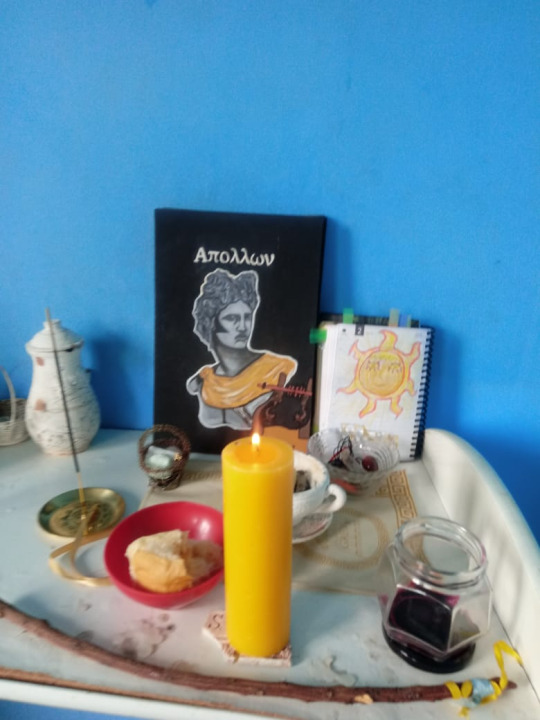
That being said, I think it’s completely possible to honour both and perceive them differently. Apollon came to me in my initial moments, when I was still only agnostic after a whole life of religous turmoil (Thank you, christianity). I prayed to Him with an amulet I got when I went to Rome, looking at the sun through my window with many things in my head.
Then, I got answered.
A dream-filled week followed after the first time I genuinely prayed to Apollon. Light, Gods and serpents entwined inmy head everytime I went to bed in such a welcoming way...I’ll never forget.
I had found my place - I prayed and I got an answer, that was so wild to me. Gods that welcomed me with open arms, bright smiles and that wanted me to seek my own virtue, in my own path towards Arète (The daimon/goddess of excellence).
In my first year, I wasn’t a polytheist. I guess I was some sort of neopagan devotee with witchy vibes that didn’t quite know what I was doing, I only knew that a God and I were building a relationship and it was wild. It took me a while to feel myself inclined to solidify my practice and worship properly, to find a schedule and to make it all make sense. That’s when I found Hellenic Polytheism, and Apollon (through divination and other signs) guided me to where I am, to the other Gods that were to be important in my life - Hekate, Ares, Hermes, Aphrodite, Artemis, Selene...Helios.
So, the Lord of Light helped me on my path towards many thigns I deem important: A solid spirituality, a set of values to guide my life, philosophy and...many things.
And as I delved deeper on polytheism, I found myself inclined to Helios too - the conflation made things a little harder to me, but it all changed when I was praying to Phoebus for some enlightment and Helios showed up not only through the Sun card, but also through my alphabetic oracle, where I got an ήτα, which bears the phrase:
“Bright Helios [Sun] {Hêlios}, who watches everything, watches you.”
And I was like: Oh, so that’s whom I’ve been feeling around me everyday too.
I made a small offering to Helios and took some more cards, looked for signs and yeah, I decided to begin honour him too - As a polytheist, as a witch (because he has SO MANY witch children in mythology, wow), as a person. Eventually I stablished that I would honour both, Apollon and Helios, as part of my lunar-month observances after the full moon, and it has been so good.
I devoted myself to Apollon, trying to incorporate some of His lessons in my life within many areas - my profession (I’m a psychologist), my daily basis (through some of the Delphic Maxims) and as a manteis (a diviner, someone who uses divination). Helios specially comes up in my mind whenever I consider the natural world, His role in it as a Giver of Life, also His All-Seeing nature as a God who knows a lot and has a lot to teach, as the Father of Witches and many other things. The Gods, each of Them, are complex beings with complex roles in the universe and deserve a lot of love!
The Gods are many and they have plenty lessons to tell us. Sometimes, we approach first and sometimes, They approach us. Either way is valid!
I wanted to share a bit of my jorney with you guys after the offering I made to Them - myrrh incense, red wine, honeyed bread and laurel leaves - because the Theoi have been so kind to me on these trying times we live in...I can only wish They are in your favour as well.
May they guide us towards our own virtues!
Eirene! (Peace!)
#helpol#hellenic polytheism#rant#apollo#apollon#helios#Apollo devotee#helios devotee#apollo deity#helios deity#apollon devotee
82 notes
·
View notes
Text
My Favorite Epithets of Artemis

Agrotera, wild, wild one, of the wild.
Philagrotis, loving the wild.
Potnia Theron, mistress of animals, queen of wild beasts; Homer used this title for her as the goddess of hunting.
Elaphaea, of the deer, deerish.
Potamia, rivery, of rivers.
Toxia, of the bow.
Iocheaira, far-shooting, she who delights in arrows, of showering arrows; describing her as a divine archeress and huntress goddess, shooter of arrows and archer queen by Homer.
Despoina Nymphê, mistress maiden.
Pheraea, of the beasts.
Skylakitis, protectress of dogs.
Drymonia, haunting the woods.
Locheia, protectress of women in childbirth; patroness of midwives.
Brauronia, protectress of girls. Her epithet at Brauron in Attica, one of the most famous worshiping sites for her in ancient Greece, where she is said to have presided over all the transitions of females from before puberty to the first childbirth. Girls began to prepare for the event of the first childbirth at an early age, and the initiation ritual was called the Brauronia, after the location of Artemis's shrine at Brauron, where the ritual, performed by girls before they reached puberty, took place.
Phaesporia/Phosphoros, light bringer, torchbearer; shining through the night and bringing light in the darkness.
Phoebe, the feminine form and lunar version of her brother Apollo's solar epithet "Phoebus", in her capacity as a godddess of the moon.
Tauropolos, bull tamer, bull herder, hunting bull goddess, goddess of Taurian divinity, goddess riding on bulls. Artemis's epithet where she was worshipped at Tauris. Tauropolia was a festival of Artemis in Athens.
Heurippa, "finder of horses". Pausanias writes in his Description of Greece of a sanctuary of Artemis at Pheneus, which legend said was founded by Odysseus. When Odysseus lost his horses and traversed Greece in search of them, he found them at this location, and it was believed that Artemis assisted him in his search. For this reason the goddess came to be called "horse finder".
Hippike, horsey, horse tamer; according to Pindar, Artemis helped Hieron of Syracuse tame his horses and thus win a Pythian chariot race.
Cynthia and Cynthius, surnames respectively of Artemis and Apollo, derived from Mount Cynthos on the island of Delos, their birthplace.
#artemis#epithets#patroness goddess#patron deity#artemis devotee#hellenic pagan#hellenic polytheism#greek mythology#ancient greece#paganism
62 notes
·
View notes
Photo



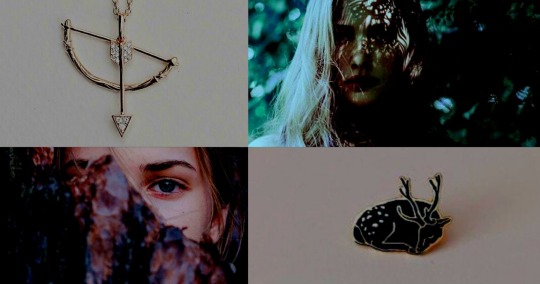
greek mythology | cult of artemis
→ one of the most famous worshiping sites for artemis was in attica at brauron.
#greek mythology#greek myth#greekmythologyedit#greekmythedit#greekedit#mythologyedit#mythedit#myedit#mine#gods and goddesses#artemis#cult of artemis#attica#brauron#aesthetic#graphics#picscam#because someone yelled at me for not doing her yet
285 notes
·
View notes
Text
The Worship of Taurian Artemis and Iphigeneia
I wanted to write this post because I worship Iphigeneia and I think it is kinda neat. There is a connection between Artemis as she was worshipped in Tauris and Iphigeneia. Iphigeneia may have been syncretized with Artemis and the goddess who was worshipped in Tauris. Artemis has a few epithets that are related to Iphigeneia.
“O′RTHIA (Orthia, Orthias, or Orthôsia) a surname of the Artemis who is also called Iphigeneia or Lygodesma, and must be regarded as the goddess of the moon. Her worship was probably brought to Sparta from Lemnos. It was at the altar of Artemis Orthia that Spartan boys had to undergo the diamastigosis (Schol. ad Pind. Ol. iii. 54 ; Herod. iv. 87; Xenoph. de Rep. Lac. ii. 10). She also had temples at Brauron, in the Cerameicus at Athens, in Elis, and on the coast of Byzantium. The ancients derived her surname from mount Orthosium or Orthium in Arcadia.” (Theoi.com-Artemis Cult titles and epithets)
“TAU′RICA (DEA) (hê Taurikê), "the Taurian goddess," commonly called Artemis. Her image was believed to have been carried from Tauris by Orestes and Iphigenia, and to have been conveyed to Brauron, Sparta, or Aricia. The worship of this Taurian goddess, who was identified with Artemis and Iphigenia, was carried on with orgiastic rites and human sacrifices, and seems to have been very ancient in Greece. (Paus. iii. 16. § 6; Herod. iv. 103.) (Theoi.com-Artemis Cult titles and epithets)
“TAURIO′NE, TAURO, TAURO′POLOS, or TAURO′POS (Tauriônê, Taurô, Tauropolo, Taurôpos), originally a designation of the Taurian goddess, but also used as a surname of Artemis or even Athena, both of whom were identified with the Taurian goddess. (Hesych. s. v. tauropolai.) The name has been explained in different ways, some supposing that it means the goddess worshipped in Tauris, going around (i. e. protecting) the country of Tauris, or the goddess to whom bulls are sacrificed; while others explain it to mean the goddess riding on bulls, drawn by bulls, or killing bulls. Both explanations seem to have one thing in common, namely, that the bull was probably the ancient symbol of the bloody and savage worship of the Taurian divinity. (Schol. ad Soph. Ajac. 172 ; Eurip. Iphig. Taur. 1457 ; Müller, Orchom. p. 305, &c. 2d ed.)”(Theoi.com-Artemis Cult titles and epithets)
Iphigenia is also mentioned alongside Artemis and the Taurian goddess in Herodotus’ Histories and Pausanias’ description of Greece. This shows that Iphigeneia was worshipped but was also syncretized with Artemis which is interesting.
“Among these, the Tauri have the following customs: all ship-wrecked men, and any Greeks whom they capture in their sea-raids, they sacrifice to the Virgin goddess1 as I will describe: after the first rites of sacrifice, they strike the victim on the head with a club; [2] according to some, they then place the head on a pole and throw the body off the cliff on which their temple stands; others agree as to the head, but say that the body is buried, not thrown off the cliff. The Tauri themselves say that this deity to whom they sacrifice is Agamemnon's daughter Iphigenia. [3] As for enemies whom they defeat, each cuts his enemy's head off and carries it away to his house, where he places it on a tall pole and stands it high above the dwelling, above the smoke-vent for the most part. These heads, they say, are set up to guard the whole house. The Tauri live by plundering and war.” (Herodotus Book 4 chapter 103)
“Pausanias has left us two sources that identify Artemis with Iphigenia: in one of them he mentions a temple of Artemis at Hermione in Argolis where this goddess is called Iphigenia (Paus. II, 35, 1), i.e. testifies of a cult of Artemis-Iphigenia; in the other – a temple of Artemis with a statue of Iphigenia in Aigira, Achaea, which according to the explanation of the periegetes meant that in ancient times the temple had been dedicated to Iphigenia” (Paus. VII. 26. 5).” (The Cult of Artemis-Iphigenia,Ruja Popova 59) “[7.26.5] There is also a temple of Artemis, with an image of the modern style of workmanship. The priestess is a maiden, who holds office until she reaches the age to marry. There stands here too an ancient image, which the folk of Aegeira say is Iphigeneia, the daughter of Agamemnon. If they are correct, it is plain that the temple must have been built originally for Iphigeneia.” (Pausanias 7.26.5)
“Near the latter is a temple of Dionysus of the Black Goatskin. In his honor every year they hold a competition in music, and they offer prizes for swimming-races and boat-races. There is also a sanctuary of Artemis surnamed Iphigenia, and a bronze Poseidon with one foot upon a dolphin. Passing by this into the sanctuary of Hestia, we see no image, but only an altar, and they sacrifice to Hestia upon it.” (Pausanias 2.35.1)
“They say that there is also a shrine of the heroine Iphigenia; for she too according to them died in Megara. Now I have heard another account of Iphigenia that is given by Arcadians and I know that Hesiod, in his poem A Catalogue of Women, says that Iphigenia did not die, but by the will of Artemis is Hecate. With this agrees the account of Herodotus, that the Tauri near Scythia sacrifice castaways to a maiden who they say is Iphigenia, the daughter of Agamemnon. Adrastus also is honored among the Megarians, who say that he too died among them when he was leading back his army after taking Thebes, and that his death was caused by old age and the fate of Aegialeus. A sanctuary of Artemis was made by Agamemnon when he came to persuade Calchas, who dwelt in Megara, to accompany him to Troy.” (Pausanias 1.43.1) “Four ideas must be kept in mind when considering this conundrum. The first is that Herodotos did travel to the Crimea personally, and thus he was a first-hand observer of this aspect of Tauric religion. Second, the historian specifies that it is the Tauroi themselves who make this claim, not Greeks who attribute this identity to a foreign deity. Third, it is obvious that both the word “Parthenos” and the name Iphigeneia are Greek, meaning that the indigenous Tauroi were clearly sufficiently influenced by their Greek neighbors by the fifth century at the latest to have adopted a foreign identification for their own goddess. Fourth, we have virtually no indigenous evidence about Tauric religion, and thus we are unable to see the native divinity behind the Greek overlay.” (Gods and Heroes: Artemis, 123)
I think that the author here raises a good question about the quotes in Herodotus’ Histories regarding Iphigeneia in Tauris, and we don’t really have an answer yet. But what is in Herodotus’ Histories combined with Iphigeneia being mentioned more than once in Pausanias’ description of Greece shows that she was worshipped even in Greece.
Bibliography
"Artemis Titles And Epithets". Theoi.Com, 2000, https://www.theoi.com/Cult/ArtemisTitles.html. Accessed 18 Jan 2021.
"Herodotus, The Histories,Book 4, Chapter 103". Perseus.Tufts.Edu, 2021, http://www.perseus.tufts.edu/hopper/text?doc=Perseus:text:1999.01.0126:book=4:chapter=103. Accessed 18 Jan 2021.
"Pausanias, Description Of Greece,Achaia, Chapter 26, Section 5". Perseus.Tufts.Edu, 2021, http://www.perseus.tufts.edu/hopper/text?doc=Paus.+7.26.5&fromdoc=Perseus%3Atext%3A1999.01.0160. Accessed 18 Jan 2021.
"Pausanias, Description Of Greece,Attica, Chapter 43, Section 1". Perseus.Tufts.Edu, 2021, http://www.perseus.tufts.edu/hopper/text?doc=Paus.+1.43.1. Accessed 18 Jan 2021.
"Pausanias, Description Of Greece,Corinth, Chapter 35, Section 1". Perseus.Tufts.Edu, 2021, http://www.perseus.tufts.edu/hopper/text?doc=Paus.+2.35.1&fromdoc=Perseus%3Atext%3A1999.01.0160. Accessed 18 Jan 2021.
Budin, Stephanie. Gods And Heroes-Artemis. Routledge, 2016, p. 123.
Popova, Ruja. "The Cult Of Artemis-Iphigenia In The Tauric Chersonesus: The Movement Of An Aition". Orpheus Journal Of Indo European And Thracian Studies, vol 18, 2011, p. 59., Accessed 18 Jan 2021.
29 notes
·
View notes
Photo
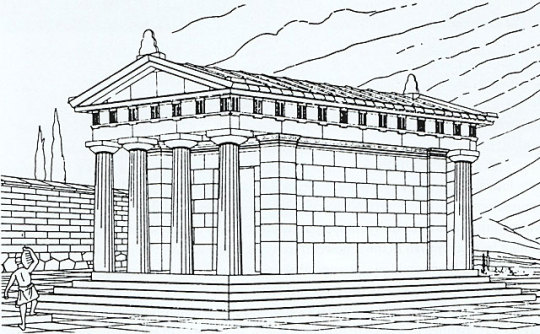
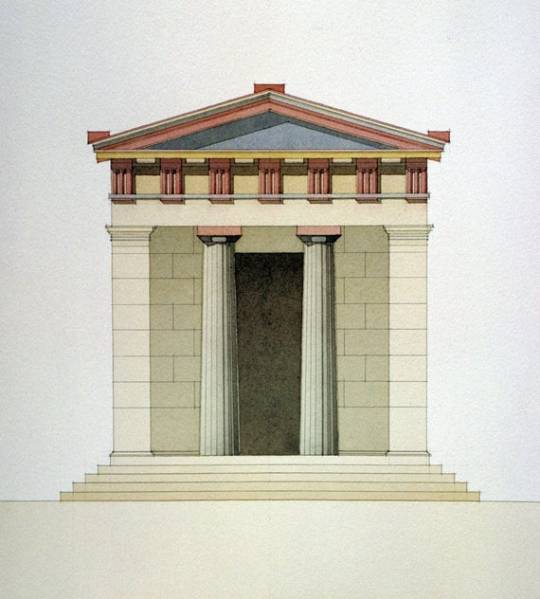
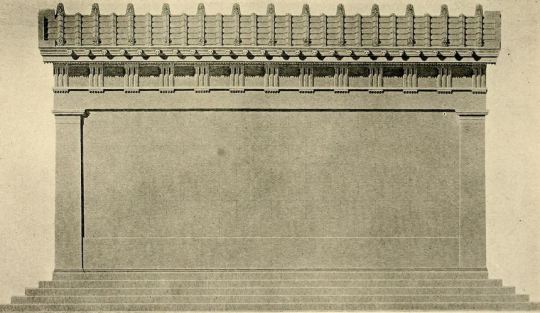
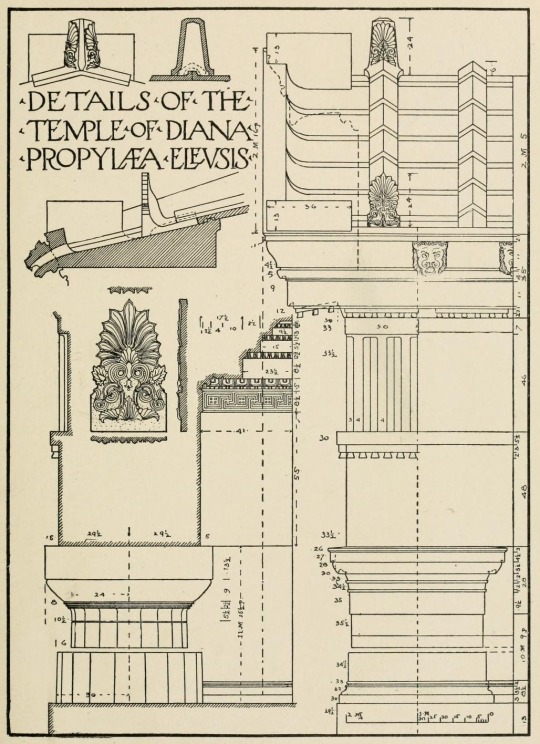
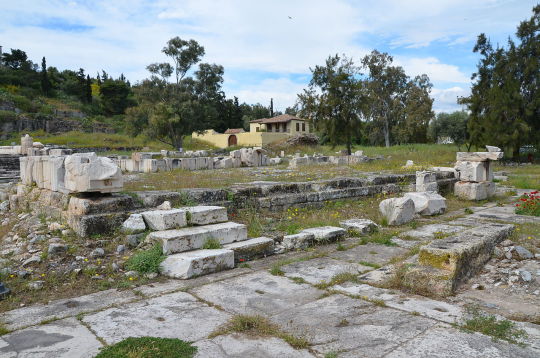
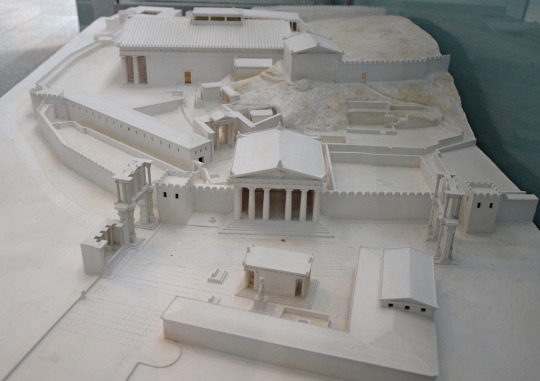
Temple of Artemis Propylaia and Poseidon Pater
Eleusis, Attica, Greece
1st century CE
The temple of Artemis Propylaea (“before the gate”) and Poseidon Pater (”the father”) was an Amphiprostyle temple outside the enclosure wall of the sanctuary of Demeter and Kore. It had front and rear porticoes with four Doric columns at each end, and a cella opening southeast onto a pronaos, and was situated on a high podium in a spacious marble-clad court. Artemis was worshipped at Eleusis as the daughter of Demeter and Poseidon. The temple was built during the reign of Marcus Aurelius from Pentelic marble. Here the mystai (followers of the Eleusian Mysteries) gathered to undergo the cleansing rites which were mandatory before entering the sanctuary itself.
Around the Temple and the forecourt was an L-shaped stoa with 6 rooms.
Note: some of the reconstructions show an Antae temple - that the temple was previously thought to be.
#art#Architecture#travel#histor#artemis#poseidon#Artemis Propylaia#Poseidon Pater#eleusis#attica#greece#roman#roman art#roman architecture#1 ce#doric#Amphiprostyle#polychrome
282 notes
·
View notes
Text
“Before the Hellenistic period, Hermes is more frequently associated with nymphs in cult, literature, and art than any other Olympian deity, including Artemis. From the battle of Marathon (490) through the fourth century, Pan's worship spread from Arcadia to other areas including Attica and Delphi. Pan quickly came to fill the position vis-a.-vis the nymphs that had earlier been Hermes'. The Corycian cave became the cave of Pan and the Nymphs, though the earliest dedications and literary allusions mention only the Nymphs. It is not unlikely that the cave may have been sacred at first to Hermes and later passed into the sphere of Pan, who in many ways succeeded Hermes as the companion of the nymphs.“
— The Corycian Nrmphs and the Bee Maidens of the Homeric Hymn to Hermes, Jennifer Larson
28 notes
·
View notes
Text
Lupercalia pt 3.

Chthonic, Apotropaic, Purification, and Fertility
Let us continue with Lycaeus. Classical Greek religion, as it was with the Italian Ligurians, was a blend of the cults of the indigenous peoples inhabiting the Aegean Sea (the Pelasgians) and Aryan settlers during the Bronze Age.
The Pelasgians were agrarian, buried their dead, and exhibited a belief in the afterlife. They had an earth mother as a supreme object of worship, similar to the Rhea or Cybele. She personified the life giving qualities of the earth, rain, crops, and fertility, but was also fearsome: she inflicted disease, attacked herds with predatory beasts, or unleashed the buried dead. As the Pelasgians were a settled people Her worship was highly localized. Figures of men in animal skins found on gems or seals are interpreted to be her priests, honoring her by wearing the pelts of sacred animals.
Homage was paid to her in the form of fertility rites to secure the rains and good harvest. If She withheld her boons her devotees would turn to rites of purification to rid themselves of the offending human sin. This would involve human sacrifice, as seen in archaeological evidence and in fables such as the Minotaur. This chthonic religion is uniquely non-Hellenic, bearing no resemblance to primitive Aryan religion.[x]
The Aryans were nomadic in lifestyle, their dead were cremated, their gods were anthropomorphic and traveled with them. This is reflected in the Homeric Poems: indifference to chthonic deities, the use of funeral pyres, no tombs or cults for the worship of heroes, and no dread of ghosts or demons. They worshiped variations of a supreme sky god or All-Father. In time, the integration of the Aryans into the Mediterranean displaced goddess worship, subordinating Her to he who would become Zeus.
The Aryans, finding themselves settling down in a new land among established peoples integrated the gods they found there rather than risk either divine or political wrath (a strategy that persists into the Roman Empire). And so the Pelasgian chthonic deities did not fully disappear but rather changed form to the rites of Brauronian Artemis, the Elysian Mysteries, and (more relevant to us) human sacrifice to Zeus Lycaeus. Those regions with the least Aryan transfusion - Attica, Arcadia, Crete, Boetia, and Lycia - had the strongest presence of chthonic cults. As we have seen the pattern of deity displacement and absorption with Aryan immigration, we might conclude whenever worship is localized to a tree, natural structure, or a place there is a strong probability that the root of the worship is pre-Aryan.
Lycaeus
In Arcadia the most venerated cult belonged to the god Varro and Isidorus named Lycaeus, meaning wolf. The seat of the cult was Mount Lycaeus, its capitol Lycaon (reputedly the oldest city in Greece). Lycaeus was a destructive, chthonic god, a protector of animals, and sender of rain. He was the embodiment of the prowling danger. His shrine was something of a wildlife refuge as no men were allowed to set foot there for fear of death.
Every nine years the festival of Lycaea or Lykaia (the prototype of the Lupercalia) was held. Sacrifices were expiatory; made to appease Lyceaus and keep him from preying upon the people and their flocks. Pausanias relates the practice of human sacrifice with the sacrificial blood sprinkled on the altar and the entrails given to the priest as sacrament. It was believed those who ate of the sacrificial victim would be transformed into wolves and sent into exile until the following festival.
Frazer (the Golden Bough, iv, 83) suggests that these priests may have disguised themselves in wolf pelts to perform the rites. If so, this echoes the worship of the Pelasgian Goddess and the numerous animal disguises depicted on Cretan seals. Similarly to the tale of Valeria Luperca, the legend of the king Lycaon being transformed into a wolf by Zeus may function as an analogy for the disgust the Hellenes held for human sacrifice, their (somewhat unsuccessful) attempt to stamp out the old ways, and the installation of their own All Father. Thus Lycaeus became an adjective for Zeus Lycaeus.
As we will see in the next post this subhumation did not quite fit Zeus, and fell to another god: Pan.
<< Pt. 1
<< Pt. 2
>> Pt. 4
Further Reading
Evans, A.(1901). The Mycenaean tree and pillar cult, and its Mediterranean relations (vol. XXI, pp. 99‑204). New York, NY: London: MacMillan. Retrieved from https://archive.org/details/mycenaeantreepil00evanuoft/page/98/mode/2up
Franklin, A. M. (1921) Lupercalia: rites and mysteries of wolf worship. Retrieved from http://penelope.uchicago.edu/Thayer/E/Roman/Texts/secondary/FRALUP/home.html
Hawes, C. H. And Hawes, H. B. (1922). Crete, the Forerunner of Greece (pp. 139‑43). New York, NY: Harper & Brothers. Retrieved from https://books.google.com/books/about/Crete_the_Forerunner_of_Greece.html?id=AxQOAQAAIAAJ&printsec=frontcover&source=kp_read_button
Hogarth, D.E. (1908). Aegean Religion. In Hastings, Selbie, Gray (Eds.), Encyclopaedia of religion and ethics (Vol. 1, pp. 141‑148). Toronto, Canada: Edinburgh : T. & T. Clark. Retrieved from https://archive.org/details/encyclopaediaofr01hastuoft/page/140/mode/2up
Lutfullina, V. Wolf Strider, edited. Retrieved from https://arcusxx.tumblr.com/post/155457634588 via Pinterest
Mackenzie, D. A. (1937) Myths Of Crete And Pre Hellenic Europe (pp. xliv‑xlvii, 59‑60, 159‑62, 293‑312). London, England: Gresham Publishing Co. Ltd. Retrieved from https://books.google.com/books/about/Myths_of_Crete_and_Pre_Hellenic_Europe.html?id=7hIaAAAAMAAJ&printsec=frontcover&source=kp_read_button
Tsountas, C. and Manatt, J. I. (1897). The Mycenaean Age: A study of the Monuments and Culture of Pre-Homeric Greece (pp. 294‑302). New York, NY: Houghton, Mifflin and Company. Retrieved from https://books.google.com/books/about/The_Mycenaean_Age.html?id=rO3OAAAAMAAJ&printsec=frontcover&source=kp_read_button
#lupercalia#luperca#she wolf#hellenistic pagan#hellenistic witch#hellenic pagan#hellenic polytheism#hellenic witch#paganblr#goddess worship#mother goddess#greek mythology#feminist witch#hekatean witch#lycaeus#werewolf
44 notes
·
View notes
Quote
JG Frazer always claimed that there was no trace of totemism in religions of the Aryan race (ie, Indo-European peoples); however, the theory of survivals encouraged scholars to see parallels between so-called primitive and so-called civilized cultures. Because of the idea that cults and beliefs of savages were comparable to those practiced by ancient nations in Europe, the origin of every polytheistic God or Goddess could be traced back to a totem-deity. That is what A Lang believed. "I believe that totemism has left marks in civilized myth, ritual, and religion, and that these survivals, not a 'disease of language,' explain certain odd elements in the old civilizations." Therefore, he picked up a set of elements from the dossier of Apollo, Zeus, Demeter, but especially of Artemis, that better than others could support his hypothesis of a deity developed out of the worship of a beast-totem. Analyzing the myths of metamorphosis related to Artemis, A Lang thought to recover a trace of the oldest mythology of this Goddess that was quite comparable with myths and beliefs of the "most backward races" of the earth. In this sense, the Arcadian myth of Artemis and the she-bear was of special interest to Lang: according to Pausanias, "Lykaon had a daughter, Callisto...Zeus fell in love and mated with Kallisto. When Hera detected this, She turned Kallisto into a she-bear, and Artemis, to please Hera, hit Her with Her arrow. Zeus sent Hermes and ordered Him to save the child that Kallisto was bearing in Her womb; then He turned Kallisto Herself into the constellation known as the Great She-Bear." The Arkadians viewed Kallisto's son, Arkas, as their eponymous hero and dedicated a cult to him as their ancestor. In Lang's opinion, the myth of Kallisto has all the characteristics of a totem tale: bestial metamorphosis, genesis of a human group, eponymate. Further evidence would result from the mythical-ritual complex of Artemis in Attica. According to tradition, a wild she-bear used to spend its time with humans, so it became tame. One day a virgin was playing with it; when the girl became too aggressive, the beast raged and tore the virgin's body into pieces. Her brothers, in revenge, killed the beast. Because of this a pestilential sickness fell upon the Athenians. The oracle said that this plague would cease only if the Athenians compelled their virgins to play the bear. And the Athenians decreed that no virgin might be given in marriage if she had not previously played the bear for the Goddess (εἰ μὴ ἀρκτεύσειε τῇ θεῷ). Therefore, during the Brauronia festival, Athenian pre-pubescent girls, aged between five and ten years, called arktoi, "(little) she-bears", were Artemis' servants at Brauron; this ministry was named arkteia.
“Artemis vel Diana, a Totem Goddess?” by Claudia Santi (p 2-3)
6 notes
·
View notes
Text
More Gods and Their Epithets - Selene, The Moon-Goddess.
We continue our series of posts about the Gods, this time focusing on the powerful Goddess, the titan sister of Helios: Selene, the Moon. Depicted as a woman with long hair in bright saffron robes, Selene is often depicted leading a chariot of winged horses or white heifers. She is the incarnation of the moon, presiding over its cycle and passage of time. Depictions of her sometimes carry the lunar orb and sometimes she is depicted with bull horns for the shape of her lunar crescent.
Famous in mythology for her love of the mortal Endymion, her role in the battle against Typhon in the Dionysiaca, and described as an all-seeing goddess in the Orphic hymns, Selene is a powerful and influential deity in the worship cycle of every Hellenic polytheist.

In terms of cult, Selene was more worshiped in the region of Elis, Argos and in Lacedemonia, the region of Sparta, where she received offers alongside her brother, Helios. Her dream-oracle in Thalamae revealed matters to the querent in sleep after drinking from a holy spring of water.
Her holiest festivals include the Pandia, where she appears as the mother of the full-moon goddess Pandea alongside her father Zeus. The monthly festival of Noumenia (New Moon) is celebrated following the reappearance of Selene's lunar crescent, her cycle being of vital importance to modern Hellenic worship.
As for her epithets, we will list some here:
ALTERNATIVE NAMES
Mene (Μηνη) - From ancient Greek, meaning "Moon" or "Month". It is alternatively used as one of the names of the Goddess in her aspect as the lunar satellite.
CULTIC AND POETIC EPITHETS
Aiglê (Αιγλη) / Hilaeira (Ἱλαειρα)- "Bright/ Softly-shining", these titles declare her dominion over moonlight
Pasiphae (Πασιφαε) - "All-Bright/All-Shining"
Eileithya (Ειλειθυια) - "[of] relief", Eileithya is the Greek goddess of childbirth. It is said that Selene under this aspect protects those who undergo the conception of another's life.
The all-seeing Moon Goddess is one of the most syncretized deities, having been associated in late antiquity/Roman times with the deities Diana, Luna, Artemis, and Hecate. Often by associations with the domain over childbirth, other times by the luminous or mystical aspect associated with moonlight.
In myths, one of Selene's other loves is the satyr-god of nature, Pan. Her daughters with Endymion are the Menae, Goddesses who represent the fifty moons that make up the Olympic cycle of 4 lunar years, upon which we base our modern Hellenic calendar - most often based on the calendar of the region of Athens (Attica).
May Selene's pale kisses shower us with blessings and wisdom! We close the post with her Homeric hymn:
Homeric Hymn 32 to Selene (trans. Evelyn-White) (Greek epic C7th - 4th B.C.) : "And next, sweet voiced Mousai (Muses), daughters of Zeus, well skilled in song, tell of the long-winged Mene (Moon) [Selene]. From her immortal head a radiance is shown from heaven and embraces earth; and great is the beauty that ariseth from her shining light. The air, unlit before, glows with the light of her golden crown, and her rays beam clear, whensoever bright Selene having bathed her lovely body in the waters of Okeanos (Oceanus), and donned her far-gleaming raiment, and yoked her strong-necked, shining team, and drives on her long-maned horses at full speed, at eventime in the mid-month: then her great orbit is full and then her beams shine brightest as she increases. So she is a sure token and a sign to mortal men. Once Kronides (Cronides) [Zeus] was joined with her in love; and she conceived an bare a daughter Pandeia, exceeding lovely amongst the deathless gods. Hail, white-armed goddess, bright Selene, mild, bright-tressed queen! And now I will leave you and sing the glorious of men half-divine, whose deeds minstrels, the servants of the Mousai, celebrate with lovely lips."
Mais Deuses e Seus Epítetos - Selene, a Deusa-Lua.
Continuamos nossa série de posts sobre os Deuses, dessa vez focando na poderosa Deusa, a titânide irmã de Hélio: Selene, a Lua.
Representada como uma mulher de longos cabelos em robes brilhantes de cor açafrão, Selene é frequentemente representada guiando uma carruagem de cavalos alados ou novilhas brancas. Ela é a encarnação da lua, presidindo sobre seu ciclo e passagem de tempo. Sua representação por vezes carrega o orbe lunar e, por vezes, ela é descrita com chifres de touro pela forma de sua crescente lunar.
Famosa na mitologia por seus amores ao mortal Endimião, seu papel na batalha contra Tifão nas Dionísiacas e descrita como uma deusa onividente nos hinos órficos, Selene é uma deidade poderosa e influente no ciclo de culto de todo politeísta helênico.

Em termos de culto, Selene foi mais cultuada na região de Elis, Argos e na Lacedemônia, região de Esparta, onde recebia ofertas ao lado do irmão, Hélio. Seu oráculo dos sonhos em Talamae revelava questões ao consulente durante o sono após beber de uma fonte de água sagrada.
Seus festivais mais sagrados incluem a Pandia, onde ela aparece como mãe da deusa do plenilúnio, Pandéia, ao lado de Zeus, seu pai. O festival mensal da Noumenia (Lua nova) é celebrado seguindo o reaparecimento da crescente lunar de Selene, seu ciclo sendo de vital importância para o culto helênico moderno.
Quantos aos seus epítetos, listaremos alguns aqui:
NOMES ALTERNATIVOS
Mene (Μηνη) - Do grego antigo, quer dizer "Lua" ou "Mês". É utilizado alternativamente como um dos nomes da Deusa em seu aspecto como o satélite lunar.
EPÍTETOS DE CULTO E POESIA
Aiglê (Αιγλη) / Hilaeira (Ἱλαειρα)- "Brilhante/De brilho suave", estes títulos declaram seu domínio sobre a luz lunar.
Pasífae (Πασιφαε) - "Toda-Brilhante/Toda-Reluzente" em grego antigo.
Ilítia (Ειλειθυια) - "[do] alívio", Ilítia é a deusa grega do nascimento e do parto. É dito que Selene sob este aspecto protege quem passa pelo parto e concepção da vida de outrem.
A onividente Deusa-lua foi uma das deidades mais sincretizadas com outras, tendo sido associada na antiguidade tardia/era romana com as divindades Diana, Luna, Ártemis e Hécate. Muitas vezes por associações ao domínio sobre nascimento e parto, outras vezes pelo aspecto luminoso ou místico associados ao luar.
Nos mitos, um dos outros amores de Selene é o deus-sátiro da natureza, Pã. Suas filhas com Endimião são as menae, Deusas que representam os cinquenta luares que formam o ciclo olímpico de 4 anos lunares, sob os quais baseamos nosso calendário helênico moderno - na maioria das vezes baseado no calendário da região de Atenas (Ática).
Que os beijos pálidos de Selene nos cubram de bênçãos e sabedoria! Encerramos o post com seu hino homérico, tradução de Alexandra Nikaios:
E, em seguida, as Musas de vozes doces, filhas de Zeus, bem habilidosas em canção, contam da Mene (Lua) de longas asas. De sua cabeça imortal um resplendor se mostra dos céus e abraça a terra; e grande é a beleza que se ergue de sua luz brilhante. O ar, antes apagado, incandesce com a luz de sua coroa dourada, e seus raios irradiam claramente, sempre que a brilhante Selene banha seu amável corpo nas águas do Oceano, e veste seus trajes de belas centelhas, e une sua brilhante equipe de pescoços fortes e dirige seus cavalos de longas crinas a velocidade máxima, ao anoitecer no meio do mês: então sua grande ��rbita é cheia e então seus raios brilham mais forte enquanto ela cresce. Então ela é um verdadeiro símbolo e um sinal aos homens mortais. Uma vez o Cronida [Zeus] se juntou a ela no amor; e ela concebeu e carregou uma filha, Pandéia, de excedente amabilidade entre os deuses imortais. Salve, deusa dos braços brancos, brilhante Selene, terna, rainha de longos cabelos brilhantes! E agora eu lhe deixo e canto a glória dos homens semi-divinos, cujas ações os menestreis, os servos das Musas, celebram com lábios amáveis.
32 notes
·
View notes
Photo
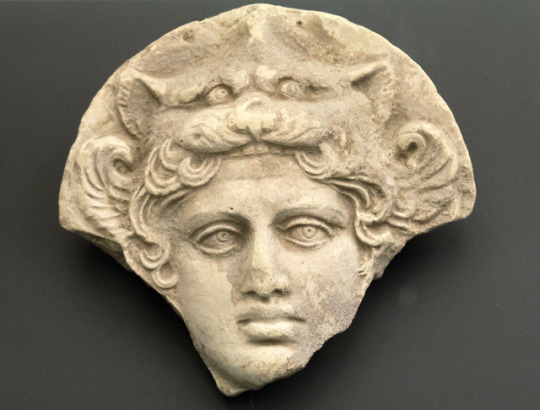
We did our coven Bendideia Saturday. Bendis, the ancient Thracian goddess of the moon and hunting, was worshipped with ecstatic rites like those of Dionysos in the wilds of Thrace, north of mainland Greece. Thracians lived in tribal villages and were renowned for their ability at war, particularly as cavalry.
The Greeks identified Bendis with Persephone, Artemis, Hekate and Selene. Bendis may have been the same as the Thracian goddess Kotys (Cotys) or a Thracian version of Cybele. Her attributes include a Thracian-style pointed hat and boots made of fox-skin. She’s shown standing between two spears or holding a torch in one hand.
She was also worshipped in Attica, in Piraeus (the harbor town of Athens). As part of the Attic ritual, a torchlight race on horseback was held in the evening in honor of the goddess. The riders carried torches and passed them along to one another as they raced the horses.
For us, she was very sweet. We had no horses for her, only torches, wine, and a bit of drumming.
5 notes
·
View notes
Photo

Marble votive relief from the sanctuary of Artemis at Brauron, Attica, showing a group of worshipers approaching the goddess (left), who is attended by a stag, one of her characteristic animals. Artist unknown; ca. 350 BCE. Now in the Archaeological Museum of Brauron.
#classics#tagamemnon#Ancient Greece#Hellenic polytheism#Greek religion#classical mythology#Artemis#art#art history#ancient art#Greek art#Classical Greece#Brauron#Attica#votive#sculpture#relief sculpture#marble#stonework#carving#Archaeological Museum of Brauron
331 notes
·
View notes